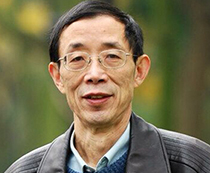-
首页
-
师资队伍展开 / 收起
 教授简介
教授简介陈平,北京大学国家发展研究院/中国经济研究中心教授(已退休)。自称研究经济问题的物理学家。陈平教授1968年毕业于北京中国科学技术大学物理系,1987年获德克萨斯大学奥斯汀校区物理学博士,导师普里戈金 (Ilya Prigogine) 教授是1977年诺贝尔化学奖获得者,非平衡态统计物理与耗散结构理论奠基人。陈平教授研究范围包括宏观经济学,金融经济学,微观经济学,计量经济学,制度经济学,复杂经济学,政治经济学,转型与发展经济学,演化经济学,文化人类学,经济史,科学史等。
-
北大国发院退休教授
-
宏观经济学,金融经济学,微观经济学,计量经济学
 学术论文
学术论文【已发表的主要英文论文】
Transition Probability, Dynamic Regimes, and the Critical Point of Financial Crisis,” (co-authored with Yinan Tang), Physica A, (2015)(to appear).
“Has Capitalism Defeated Socialism Yet? - - Kornai’s Turnaround on Liberalism, and the Evaporation of Myths about Eastern Europe,” International Critical Thought, 5(1), March (2015).
“Disillusion in Utopian Capitalism and Lessons to the Development of China,” World Review of Political Economy, 5(3), 414-429 (2014).
“Time Varying Moments, Regime Switch, and Crisis Warning: The Birth-Death Process with Changing Transition Probability,” (co-authored with Yinan Tang), Physica A, 404, 56-64 (2014).
“Metabolic Growth Theory: Market-Share Competition, Learning Uncertainty, and Technology Wavelets” Journal of Evolutionary Economics, 24(2), 239-262 (2014).
“Trend, Randomness, and Noise: Exogenous vs. Endogenous Explanation in Complex Heterodox Analysis (A Note on Nicolas Bouleau in RWER 60)” (co-authored with Yian Tang, Tang, Yinan, Wolfram Elsner, and Torsen Heinrich), Real World Economics Review, no.62 (2012).
“China Approach in a Changing World,” Invited Keynote speech at 6º. FORUM DE ECONOMIA DA FUNDAÇÃO GETÚLIO VARGAS, Sao Paolo, Brazil, Sept.22, 2009. In Bresser-Pereira, Luiz Carlos, ed. Depois da Crise. A China no centro do mundo? (After the Crisis, China in the Center of the World?), Rio de Janeiro: Editora FGV (2011).
“From an Efficient to a Viable International Financial Market,” in R. Garnaut, L. Song and W.T.Woo eds. China’s New Place in a World in Crisis: Economic, Geopolitical and the Environmental Dimensions, Chapter 3, pp.33-57, Australian National University E-Press and The Brookings Institution Press, Canberra (2009).
“Three Dimensions of Current Economic Crisis,” in Looking for Solutions to the Crisis: The United States and the New International Financial System, Conference Proceedings, New York, Nov. 14, 2008, EPS (Economists for Peace and Security) and IRE(International Initiative for Rethinking the Economy), Published in Clamecy, France (2009)
“Equilibrium Illusion, Economic Complexity, and Evolutionary Foundation of Economic Analysis,” Evolutionary and Institutional Economics Review, 5(1), 81-127 (2008).
“Complexity of Transaction Costs and Evolution of Corporate Governance,” Kyoto Economic Review, 76(2), 139-153 (2008).
“What economists can learn from complex dynamics? Future dynamical foundation of economic theory,” PROCEEDINGS OF THE 2007 CONFERENCE ON SYSTEMS SCIENCE, MANAGEMENT SCIENCE AND SYSTEM DYNAMICS: SUSTAINABLE DEVELOPMENT AND COMPLEX SYSTEMS, VOLS 1-10 (219-233) 2007.
“Market Instability and Economic Complexity: Theoretical Lessons from Transition Experiments,” in Yang Yao and Linda Yueh Eds. Globalisation and Economic Growth in China, Chapter 3, pp.35-58, World Scientific, Singapore (2006).
“Evolutionary Economic Dynamics: Persistent Business Cycles, Disruptive Technology, and the Trade-Off between Stability and Complexity,” in Kurt Dopfer ed., The Evolutionary Foundations of Economics, Chapter 15, pp.472-505, Cambridge University Press, Cambridge (2005).
“Microfoundations of Macroeconomic Fluctuations and the Laws of Probability Theory: the Principle of Large Numbers vs. Rational Expectations Arbitrage,” Journal of Economic Behavior & Organization, 49(3), 327-344 (2002).
“Instability, Complexity, and Bounded Rationality in Economic Change” (with I. Prigogine and K. H. Wen), in W. W. Coopper, D. V. Gibson, F. Y. Phillips, S. A. Thore, and A. B. Whinston eds. Impact - - How IC2 Research Impact Public Policies and Business Practices , Chapter 11, pp.209-218, Greenwood Publishing Group, CT: Westport (1997).
“A Random Walk or Color Chaos on the Stock Market? - Time-Frequency Analysis of S&P Indexes,” Studies in Nonlinear Dynamics & Econometrics, 1(2), 87-103 (1996).
“Trends, Shocks, Persistent Cycles in Evolving Economy: Business Cycle Measurement in Time-Frequency Representation,” in W. A. Barnett, A. P. Kirman, and M. Salmon Eds. Nonlinear Dynamics and Economics, Chapter 13, pp. 307-331, Cambridge University Press (1996).
“Evolving Multi-Humped Distributions of Stock Market Prices - An Empirical Observation of Nonequilibrium Behavior” (with K. H. Wen, and Z. L. Zhang), Annals of Operations Research, Vol. 68, pp. 425-441, Computational Economics, eds. by G. L. Thompson and S. Thore, Baltzer Science Publishers, Amsterdam, Netherlands (1996).
“Economic Data Analysis,” in Shie Qian and Dapang Chen, Joint Time-Frequency Analysis, Chapter 12, pp. 253-264, Prantice Hall, NJ: Upper Saddle River (1996).
“Deterministic Cycles in Evolving Economy: Time-Frequency Analysis of Business Cycles,” in N. Aoki, K. Shiraiwa, and Y. Takahashi Ed. Dynamical Systems and Chaos, Vol. I, pp. 363-372, World Scientific, Singapore (1995).
“Study of Chaotic Dynamical Systems via Time-Frequency Analysis,” Proceedings of IEEE-SP International Symposium on Time-Frequency and Time-Scale Analysis, Philadelphia, Oct. 25-28, pp. 357-360 (1994).
“Bifurcation and Chaos in a Lienard Equation with two delays” (with K. H. Wen and J. S. Turner), in M. Sambandham ed., The Proceedings of Dynamic Systems and Applications, 1, 377-384, Dynamic Publishers, Atlanta (1994).
“Searching for Economic Chaos: A Challenge to Econometric Practice and Nonlinear Tests,” In Richard Day and Ping Chen Eds. Nonlinear Dynamics and Evolutionary Economics, Chapter 15, pp. 217-253, Oxford University Press (1993).
“China's Challenge to Economic Orthodoxy: Asian Reform as an Evolutionary, Self-Organizing Process,” China Economic Review, 4, 137-142 (1993).
“Imitation, Learning, and Communication: Central or Polarized Patterns in Collective Actions,” in A. Babloyantz ed., Self-Organization, Emerging Properties and Learning, pp. 279-286, Plenum, New York (1991).
“Nonequilibrium and Nonlinearity - A Bridge Between the Two Culture,” George Scott ed., Time Rhythms and Chaos in the New Dialogue with Nature, Chapter 4, pp.67-86, University of South Dakota at Vermillion, Iowa State University Press (1990).
“Needham's Question and China's Evolution - Cases of Nonequilibrium Social Transition,” George Scott ed., Time Rhythms and Chaos in the New Dialogue with Nature, Chapter 11, pp.177-198, University of South Dakota at Vermillion, Iowa State University Press (1990).
“Multiperiodicity and Irregularity in Growth Cycles: A Continuous Model of Monetary Attractors,” Journal of Mathematical and Computer Modeling, Vol. 10, No. 9, 647-660 (1988).
“Deterministic Chaos and Fractal Attractors as Tools for Nonparametric Dynamical Econometric Inference” (co-authored with W. A. Barnett), Journal of Mathematical and Computer Modeling, Vol. 10, No. 4, 275-296 (1988).
“The Aggregation-Theoretic Monetary Aggregates are Chaotic and Have Strange Attractors: An Econometric Application of Mathematical Chaos” (co-authored with William A. Barnett), in Dynamic Economic Modeling, W. A. Barnett, E. Berndt, and H. White eds. Chapter 11, pp.199-245, Cambridge University Press, Cambridge (1988 ).
“Empirical and Theoretical Evidence of Economic Chaos,” System Dynamics Review, Vol. 4, No. 1-2, 81-108 (1988). 该文多次作为经济混沌的代表作,被收入混沌研究的论文集中。
“Economic Theory as a Generator of Measurable Attractors” (co-authored with William Barnett), in the Laws of Nature and Human Conduct, Specifities and Unifying Themes, Discoveries 1985 Symposium, Brussels, 7-9 October 1985, I. Prigogine and D. Sanglier eds. Task Force of Research Information and Study on Science, Brussels (1987), pp. 209-224.
“Origin of Division of Labor and Stochastic Mechanism of Differentiation,” European Journal of Operational Research, Vol. 30, No. 3, pp. 246-250 (1987).
(English Book)
Chen, Ping. Economic Complexity and Equilibrium Illusion: Essays on Market Instability and Macro Vitality, London: Routledge (2010).
Day, R. and Chen, P. Nonlinear Dynamics and Evolutionary Economics, Oxford, Oxford University Press (1993).
Chen, Ping. Nonlinear Dynamics and Business Cycles,Ph.D. Dissertation, University of Texas at Austin,May 1987。
【已发表的主要中文论文】
陈平,“经济周期理论的弗里希模型之谜:均衡经济学和永动机模型”, 《政治经济学报》,2015年,第4卷, 41-54页。
陈平,“代谢增长论: 市场份额竞争,学习不确定性和技术小波”, 《清华政治经济学报》,2014年,第2卷,第1期, 26-52页。
陈平,科斯问题,张五常颠覆,和经济组织的复杂性(2014), 天则经济研究所,《科斯纪念文集》(将发表)。
陈平,从自由主义到新保守主义:评科尔奈“近在眼前的威胁”,《金融时报》中文版,2014年8月11日,《马克思主义研究》2014年(将发表)。
陈平,金砖银行开启后美国金融时代,《经济导刊》2014年8月.
陈平,“代谢增长论: 市场份额竞争,学习不确定性和技术小波”, 《清华政治经济学报》,2014年,第2卷,第1期, 26-52页。
陈平,“新自由主义的警钟:资本主义的空想与现实”,《红旗文稿》2014年,12期。《政治经济学评论》(2014)(将发表)。
陈平,“资本主义的空想与现实”,英国《金融时报》中文版,2014年5月29日。
陈平,”科斯问题和普里戈金视角:来自工业和科学的实践经验”, 《学术界》,2014年第1期,29-37页。
陈平,“金融危机与经济学流派的实践检验”,《演化与创新经济学评论》,2013年(将发表)。
陈平,“探索繁荣真意:评林毅夫《繁荣的求索》”,《第一财经日报》,2012年11月9日。
陈平,“中国道路的本质和中国未来的选择”,《经济社会体制比较》,2012年第3期,1-23页。
陈平,“中国道路的争议和新古典经济学的迷思”,《政治经济学评论》,2012年,第3卷,第2期,39-75页。
陈平,“走出凯恩斯-弗里德曼的流动性陷阱:后金融危机时代的宏观演化经济学“,《演化与创新经济学评论》,2012年第1辑,45-53页。
陈平,“土地流转,城市模式,与农民转业”,《人民论坛-学术前沿》,总第336期,2011年8月15日,12-15页。
陈平,“均衡幻象,经济复杂和经济分析的演化基础”,《演化与创新经济学评论》,2011年第1辑, 42-77页。
陈平,“告别摸石头过河,走向观全局航海”,《人民网-理论频道》,2010年10月18日。
陈平,“均衡幻象,经济复杂和经济分析的演化基础”,《演化与创新经济学评论》,2011年第1辑,42-77页。
陈平,“从‘民富国强’与‘国泰民安’的两条道路之争谈起“,《红旗文稿》2010年第23期,第8-11页。
陈平,“中国之谜与中国之道 “,《红旗文稿》2010年第4期。
陈平,“纪念经济科学家保罗-萨缪尔逊:数理经济学的奠基人和经济学变革的先知者”,《经济学动态》,2010年2月,46-52页。
陈平,“有效市场的失败与生机市场的发展--重建国际金融秩序的一个新视角”, 收入郜若素、胡永泰、宋立刚编,《全球金融危机下的中国:经济、地缘政治和环境的视角》,第3章,社会科学文献出版社,北京(2010)。
陈平,“经济复杂与均衡幻象:关于市场非稳定与宏观生机的论文集”,《演化与创新经济学评论》,2010年第3辑,16-26页。
陈平,“交易成本的复杂性与公司治理的演化”,《演化与创新经济学评论》,2010年第1辑,1-12页.
陈平:“告别摸石头过河 走向观全局航海”,《人民网-理论频道》记者采访“ 五中全会前瞻系列六”,2010年10月18日,http://theory.people.com.cn/GB/12976180.html
陈平,“中国经济崛起的成功经验”,《中国社会科学报》,2010年1月7日。
陈平,“西方金融危机的前景和中国金融的全球战略”,《新华社内参》,2008年11月6日。
陈平,“世界格局的演变和中国金融的发展战略”,《改革内参》2008年, 第30期,18-22页,10月20日。
陈平, 科斯谬想,张五常猜测,与交易成本的复杂性,北京大学中国经济研究中心 简报, 2008年17期,2008年4月19日。
陈平, ”私有制的神话和多种所有制的现实 ——德国蔡司光学仪器公司、美国大学联邦信用社和MIT学生之家的经验及启示”,史正富和刘昶编,《民营化还是社会化:国企产权改革的战略选择》,世纪出版集团, 2007年3月出版。
陈平, ”新古典经济学在中国转型实验中的作用有限”,经济研究,2006年10月。
陈平, ”从华盛顿共识失败看经济学变革方向”,红旗文稿,2005年第11期,13-15页,2005年6月10日出版。
陈平, ”经济混沌和经济波动的非线性动力学理论”,收入《面向21世纪人文社会科学100个重大问题》,山东教育出版社(2005)。
陈平, ”华盛顿共识的失败与经济学变革方向-陈平教授在北京大学的讲演”,文汇报,2005年5月15日,第6版。
陈平, ”纪念演化物理学家普里高津”,科学文化评论,第1卷,第5期,30-35页,2004年10月出版。
陈平, ”从李约瑟问题看中西科技体制和学风的差距”,科学对社会的影响,2002年第2期,49-57页,2002年6月25日出版。
陈平, ”建立中国统一的社会保障体系是自损国际竞争力的短视国策”,中国改革,2002年第4期。
陈平, ”劳动分工的起源和制约-从斯密困境到广义斯密原理”, 经济学(季刊), 第1卷,第2期(2002年1月)。陈平,金融工程--后冷战时代全球竞争的新战场 (1998) 。
陈平, 政治清醒、经济迷误、文化色盲 – 评亨廷顿的文明冲突论和后冷战时代的世界格局(1997)。
陈平, 后冷战时代两岸关系的互动与展望-区域非平衡的政治经济学分析(1996)。
陈平, 生态经济、地缘政治,发展战略,和经济外交 -从全球竞争的角度看中美关系及东亚格局(1996)。
陈平, 金融改革的战略选择和经济秩序的良性循环(1996)。
陈平, 经济改革的现实问题和战略选择-从国企困境、信用瓦解、及民富国穷的源由谈起(1996)。
陈平, 中国土地制度的政治经济学及其超越 - -在生态、人口、技术、和文化制约下的演化动力学研究(1994)。
陈平, 太平洋地区的发展前景和中国经济联合的全球地位(1988)。
陈平, 中国单一封闭的小农经济结构分析(1982)。
陈平, 技术革命的道路和技术经济的规律(1981-82)。
陈平, 社会传统和经济结构的关系(1981)。
陈平, 社会演化的发展观与经济结构的方法论(1981)。
陈平, 经济结构的规律和社会演化的模式(1981)。
陈平, 对于中国科学落后的历史根源的探讨(1980)。
陈平, 技术革命史分期问题初论(1980)。
陈平, 关于社会史研究的方法论问题-答沈元瀚同志(1980)。
陈平, 单一小农经济结构是我国长期动乱贫穷、闭关自守的病根, 《人民日报》与《光明日报》1979年11月16日同时发表(1979)。
陈平,历史上的科学人才-科学家成长因数的调查报告, 《人民教育》1979年第四期,全国数十家报刊转载(1979)。
陈平,彻底的探索者-纪念爱因斯坦(1979)。
陈平,科技战略史研究札记(部分)(1978)。
[注:2000年以前的论文多已收入陈平论文集:《文明分岔、经济混沌、和演化经济动力学》,北京大学出版社,北京2004年版。
【与研究生合作发表的论文】
唐毅南,陈平,”群体动力学和金融危机的预测”,《经济研究》,2010年,第6期,53-65页。
唐毅南,陈平,”趋势与波动相关下的期权定价模型”,《金融评论》,2010年,第2期,1-11页。
唐毅南、陈平,“S形需求曲线的动态起源:消费者社会相互作用下时尚商品的群体模型”,《经济学(季刊)》,第8卷,第3期,1013-1028页,2009年4月。
李华俊、陈平,”风险发展环境下的困境、对策比较:安徽和广西农村个案”,《改革》2008年第10期,95-101页。
曾伟,陈平,“波动率微笑、相对偏差和交易策略——基于非线性生灭过程的股票价格一般扩散模型”,《经济学(季刊)》, 2008年第7卷第4期,1415-1436页。
丁琳, 陈平, ”银行垄断、信用危机和金融改革”,改革,2000年第2期。
丁琳,陈平,“一个中国各地区经济增长的实证研究,”经济科学,1998年第4期,46-54页。
【中文论文集】
陈平,文明分岔、经济混沌、和演化经济动力学,北京大学出版社,北京2004年出版。
陈平,文明分岔、经济混沌、和演化经济学,经济科学出版社,北京2000年出版。
陈平集 - 封闭,冲击,演化,黑龙江教育出版社,哈尔滨1988年版。
【英文论文集】
Chen, Ping. Economic Complexity and Equilibrium Illusion: Essays on Market Instability and Macro Vitality, London: Routledge (2010).
Day, Richard and Chen, Ping. Nonlinear Dynamics and Evolutionary Economics, Oxford University Press, Oxford (1993)。
Chen, Ping. Nonlinear Dynamics and Business Cycles,Ph.D. Dissertation, University of Texas at Austin,May 1987。
 教授观点
教授观点-
陈平:纪念坚持科学精神的演化历史学家诺斯
2015-12-03 -
陈平:对西方模式的迷恋导致了这次股灾
2015-07-06 -
陈平:调结构的三条道路——与吴敬琏、林毅夫商榷
2015-01-23 -
陈平:揭开QE退出的迷雾
2014-11-05
国家发展研究院官方微信
Copyright© 1994-2012 北京大学 国家发展研究院 版权所有, 京ICP备05065075号-1
保留所有权利,不经允许请勿挪用




